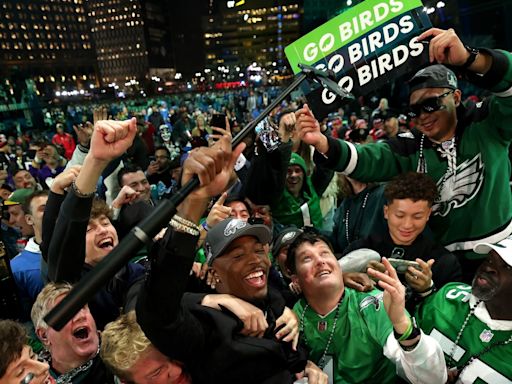Search results
Mar 1, 2024 · Dune: Part Two: Directed by Denis Villeneuve. With Timothée Chalamet, Zendaya, Rebecca Ferguson, Javier Bardem. Paul Atreides unites with Chani and the Fremen while seeking revenge against the conspirators who destroyed his family.
- Denis Villeneuve
- 2024-03-15
- Action, Adventure, Drama
- 150
Dune: Part Two is a 2024 American epic science fiction film directed and produced by Denis Villeneuve, who co-wrote the screenplay with Jon Spaihts. The sequel to Dune (2021), it is the second of a two-part adaptation of the 1965 novel Dune by Frank Herbert. It follows Paul Atreides as he unites with the Fremen people of the desert planet ...
3 days ago · Dune: Part 2 Rating and Runtime Dune: Part Two is Rated PG-13 for sequences of strong violence, some suggestive material, and brief strong language. The film runs for a total of 2 hours and 46 ...
- The best of us.
- Should I Play The Last of Us Before Part 2?
- In Your Opinion, Is The Original The Last of Us a 10/10?
- I Am Not Alone, Dear Loneliness
- The Last of Us Part 2 Review Screenshots
- Every IGN Naughty Dog Game Review
- I Would Like to Rage
- As a Dog Lover
- Every IGN PlayStation First-Party Exclusive Review
- Every Modern IGN 10/10 and Where to Play Them
By Jonathon Dornbush
Updated: Oct 22, 2020 8:30 pm
Posted: Jun 12, 2020 7:01 am
The Last of Us is one of the rare beloved games of the past decade that not only didn’t demand a sequel, but actively seemed to resist the idea of one. Its story is largely poignant because of how self-contained it is: not knowing what happened between Joel and Ellie after his fateful, final decision burned a mark into the brains of many who played it, and that open-ended question has lingered for years. But with The Last of Us Part 2, developer Naughty Dog rises to that challenge with not only a complex, profound story that gives it a reason to exist, but also deep and satisfying evolutions to the original’s third-person action/stealth gameplay.
I can’t tell you much about some of Part 2’s best aspects, but not because I don’t want to – I’m bursting to talk with anyone about all the moving, uplifting, and heart-wrenching moments that have been replaying in my mind for days since I first beat this adventure. But doing so would strip away layers of the act of playing through Part 2 yourself, so I’ll speak about its story in largely general terms.
One of Part 2’s biggest achievements is how it knowingly handles the weighted expectations that a sequel to one of the most heralded game stories of all time will inevitably carry with fans. It starts out seemingly simple, taking place about four years after the end of the original and setting an older, angrier, but still-immune Ellie on a quest for revenge that also hones in on the cycles of violence that can plague humanity as much as any infection. It knowingly leans into the tropes of the genre, such as guilt by association and the inevitable escalation of matching an eye for an eye and a tooth for a tooth. But those cliches are often subverted, playing into the expansive and not-so-straightforward path ahead.
I’m going to talk about the events of the original The Last of Us a bit going forward, so if you haven’t played it yet please bail out and go do that immediately. Not only because it’s still an outstanding game, but playing through the original before Part 2 – especially relatively soon before – will make its big moments resonate so much more. Part...
Yes!
No
One of the most impactful ways Part 2 hearkens back to The Last of Us is how it asks you to identify and empathize with its characters, even when you almost certainly won’t always agree with their actions. In a medium often defined by giving us the power to choose what happens, The Last of Us and Part 2 concern themselves more with fully realized characters, asking us to take them as they are. Naughty Dog’s characters are indelible, which makes for incredibly powerful and challenging moments when you’re put in Ellie's shoes and asked to act out her whims yourself.
Part 2 is peppered with brutal, tragic, and poignant moments that hit harder because you take part in them, like it or not. Even if I disagreed with an action, I didn’t have a choice in the matter. I was asked to execute those actions or watch them happen without a chance to intercede, and to understand the reasoning behind them from their perspective. This dance between interactivity and an unalterable story made for a much more affecting experience than if I’d watched it all unfold in a movie.
Preorder The Last of Us Part 2
•See it at Best Buy
At the heart of it all is Ellie and her relationships. Ellie has had time to both find herself in the Jackson, Wyoming settlement she and her flawed father figure Joel call home and to reflect on the formative moments of her childhood. Uncovering what she knows and where she stands with Joel and his brother Tommy, is, at different times painful, amusing, and cathartic, but always in ways that are true to what I knew of these characters.
Actors Troy Baker and Ashley Johnson once again bring so much heart and honesty in their performances as Joel and Ellie, respectively. Ellie is, without a doubt, the protagonist of Part 2, and Johnson brings nuance to every facet of Ellie’s character. Watching her grow up and wrestle with her past while still learning who she is as a 19-year-old (with all the usual desires and shortfalls 19-year-olds generally possess) is riveting at every step. She delivers some of the most human moments that Part 2 serves up.
Baker is no less fantastic as Joel, even though Ellie is in the more prominent playable role. However you may feel about Joel’s decisions in the original, Baker sells the weariness of a man who has taken many lives to save his own and made questionable moral decisions out of love. Seeing him reckon with a surrogate daughter who both cares for him and yet keeps him at arm’s length is devastating to watch. Taking a cue from 2014’s prequel expansion, The Last of Us: Left Behind, Part 2 allowed me to live in moments between Joel and Ellie, which offered up a quiet reflection of why they view the world they do.
Even when she does horrible things, her motivations are just as legitimate as Joel's or Ellie's.
“
Part 2 also introduces a great cast of supporting characters. Shannon Woodward is instantly charming as Dina, bringing a joy and kindness to a world where it’s otherwise so tough to find. Woodward shines in the smaller moments — a joking jab at Ellie here or an amusing aside about their Jackson homestead, there — offering so much dimension to the character. It’s also important to highlight, in spoiler-free terms, the incredible performance by Laura Bailey (known for her roles as Mary Jane from Marvel’s Spider-Man and Kait Diaz from Gears 5, among numerous others) as a new character. Like so many of The Last of Us’ characters, calling her good or evil would be reductive – we see her at her best and most relatable as well as her worst. It’s a testament to The Last of Us Part 2’s script by Neil Druckmann and Halley Gross and Bailey’s performance that even when she does horrible things, her motivations are just as legitimate and arguably noble as Joel’s or Ellie’s.
The way Naughty Dog uses the larger, community-based conflict between the warring groups in Seattle also helped avoid the fatigue that set in with the latter acts of Uncharted 4. Even though it took me about 25 hours to complete (10 hours longer than the original), Part 2 never dragged or felt padded out thanks to the large cast and Naughty Dog’s e...
Those conflicts play out with some very familiar stealth, action, and puzzle sequences. That said, one of the biggest critiques of the first game is that its combat and puzzle segments weren’t deep enough to avoid repetition over its 15 hours, and Part 2 has taken major steps to remedy that and add variety to gameplay – some of which seem obvious in hindsight. For example, it’s silly to think that adding a jump button in 2020 could feel so fresh, but it most definitely proves to be key to Part 2’s many enthralling combat encounters. Ellie is far more nimble than Joel, able to jump, swing, and climb over and under things to more carefully avoid or stalk enemies. That not only made my options feel exponentially more varied, but also allowed the level design around these encounters to be more open and diverse at every step.
From underground caverns to dilapidated office and apartment buildings to the lush, overgrown streets of a Seattle being reclaimed by nature, Part 2’s stealth combat is easy to understand but consistently exciting to try and master with every new fight. Part of that comes from the scope of its battlefields: they take place in areas like multi-tiered shopping malls or fragmented skyscrapers that offer what feel like naturally complex puzzle boxes. There was always plenty of room, both literally and mechanically, to sneak around and pick off enemies one by one, go in guns blazing, or (as usually happened for me) plan to be stealthy but get caught and scramble to narrowly escape danger.
Ellie’s ability to jump, go prone, dodge, and even run away from combat not only takes advantage of these large spaces, but also enables that improvisation within them, pushing you to adapt to any situation or meet a quick death. Enemies don’t just stick to set patterns; they’re reactive to the environment around them.
While giving every human enemy a name and the ability to communicate with each other more effectively while searching for you seems somewhat superfluous at first, the practical application of it was always clear after I’d killed an enemy or two in any given fight. The Washington Liberation Front enemies, seeing a friend or loved one dead on the ground, would immediately switch up their search pattern, taking note of recently downed enemies and possible escape routes the killer could have taken from that spot. Simply hearing my enemies verbally work through their plans, rather than just going about their patrol routes, instilled so much more tension into every fight.
Learning the ins and outs of each faction added another interesting layer to combat.
“
In The Last of Us Part 2, dogs are a major threat because they can sniff you out even when Ellie’s well-hidden from humans. You can distract them with throwable bottles or bricks, but if you don’t keep moving they’ll inevitably pick your scent back up. As a dog owner, I found it horrifying to be confronted with a situation in which I have to kill a dog (as opposed to a human who’s made a conscious decision to fight you to the death). No, they’re not real, but Naughty Dog has done an amazing job of animating their namesakes in lifelike ways. While you can’t feed treats to or play fetch with the dogs in the middle of battle, if it’s just too much to have to subdue one, I suggest sprinting away for your life. Dogs can pick up your scent, if you’re far enough away they become disinterested in you until they eventually amble closer to you on the map. Heights are your friend as well because, unlike Air Bud, there’s something in the Last of Us rulebook about dogs not being allowed to climb ladders. I often used those techniques to avoid watching Ellie do something I never could.
Part 2’s expansive environments aren’t just there to be sandboxes of death, though. The artfully detailed and realized locations tell layers of story, from the macro-destruction of a certain city district down to the posters and calendars hung on abandoned apartment walls. Some of the original Last of Us’ most interesting bits of backstory were found in scattered notes and diary pages, and the jump in detail for Part 2 astounded me. It seems as though every room has a story to tell, every office has a history, every store shows a place or group of people frozen in time. I spent more time than I’d care to admit studying abandoned D&D games in apartments, listening to ancillary conversations, and trying to read deteriorating book covers. Whether I found equipment and crafting materials or not, the thoughtful intent in each one of these objects and interactions made exploring feel valuable regardless.
I never once had to grab a floating palette to serve as a raft for someone who couldn’t swim.
“
And while Part 2 is not an open-world game, it does include an open-world area that learns lessons from Uncharted 4 and Lost Legacy’s attempts at the same design idea, this time to much better effect. While those games presented areas of open, explorable wildernesses, they often didn’t have much to find there, making exploration feel somewhat aimless. In Part 2, though, a dilapidated district of Seattle offers years of lost history, a mixture of events frozen in time by the pandemic and those who have tried to survive here since. Its scope and scale won’t challenge Rockstar’s open-world games any time soon, but it shakes up the pacing in a needed way and is thoughtfully used by Naughty Dog to not only explain Part 2’s setting at large, but also allow for a number of welcome, discoverable character moments.
Its scope and scale won’t challenge Rockstar’s open-world games any time soon, but it shakes up the pacing in a needed way.
“
But even outside of that area, Jackson, other parts of Seattle, and more are gorgeous and memorable locations. The Wyoming countryside is lovely, too, whether it be mountains covered in bright snow or fields of wheat shining in the evening sunset. And sure, the Pacific Northwest is as rainy as you would expect, but Naughty Dog has taken the gloom of grey clouds and grey buildings and crafted something ominous, beautiful, and haunting. Lush vegetation grows over dilapidated storefronts and homes in the suburbs while the smashed, looming skyscrapers of the city form new, mesmerizing stone monuments. Seven years and a new generation has allowed Naughty Dog to create locations that, while very much like the ruined vestiges of civilization in the original, are so much more richly detailed, with more distinct and varied interiors, striking outdoor lighting, and inventive new locations that play to Seattle’s seaside setting.
Evocative audio design, backed by the moving score of returning composer Gustavo Santaolalla, plays a big role as well. It all comes down to the little details: characteristically for the region, the oppressive thump of rain masks the terrifying noises of the infected that lurk outside; the slam of debris that blocks a doorway and the quiet creakin...
Rated: 2.5/4 • Apr 19, 2024. "Dune: Part Two" will explore the mythic journey of Paul Atreides as he unites with Chani and the Fremen while on a warpath of revenge against the conspirators who ...
- (413)
- Denis Villeneuve
- PG-13
- Timothée Chalamet
Feb 21, 2024 · Verdict. Dune: Part Two expands the legend of Paul Atreides in spectacular fashion, and the war for Arrakis is an arresting, mystical ride at nearly every turn. Denis Villeneuve fully trusts his ...
Feb 29, 2024 · February 29, 2024 2:18 PM EST. F ollowing a two-year hiatus—and an additional four-month delay brought on by the WGA and SAG-AFTRA strikes— Dune: Part Two is set to arrive in theaters on March ...



